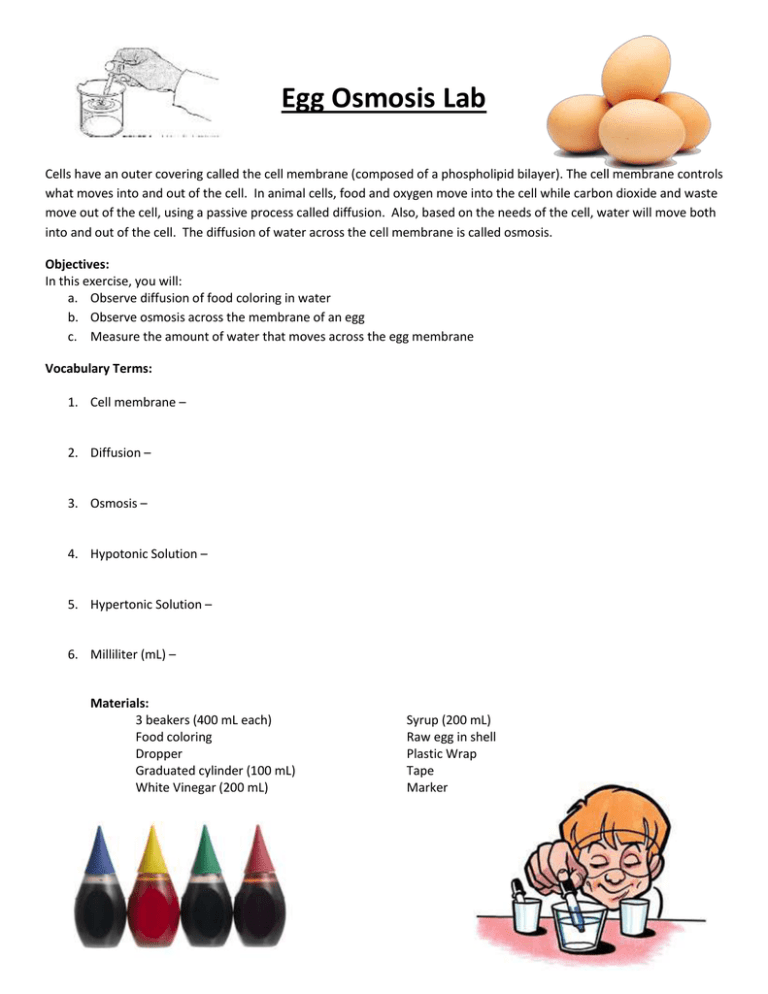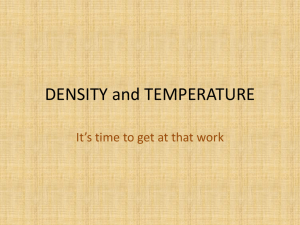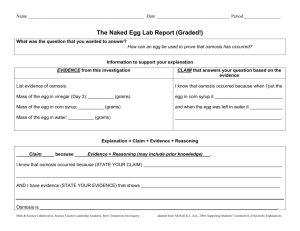Egg Osmosis Lab
advertisement

Egg Osmosis Lab Cells have an outer covering called the cell membrane (composed of a phospholipid bilayer). The cell membrane controls what moves into and out of the cell. In animal cells, food and oxygen move into the cell while carbon dioxide and waste move out of the cell, using a passive process called diffusion. Also, based on the needs of the cell, water will move both into and out of the cell. The diffusion of water across the cell membrane is called osmosis. Objectives: In this exercise, you will: a. Observe diffusion of food coloring in water b. Observe osmosis across the membrane of an egg c. Measure the amount of water that moves across the egg membrane Vocabulary Terms: 1. Cell membrane – 2. Diffusion – 3. Osmosis – 4. Hypotonic Solution – 5. Hypertonic Solution – 6. Milliliter (mL) – Materials: 3 beakers (400 mL each) Food coloring Dropper Graduated cylinder (100 mL) White Vinegar (200 mL) Syrup (200 mL) Raw egg in shell Plastic Wrap Tape Marker PROCEDURE: Part A. Diffusion 1. 2. 3. 4. Add 300ml of water to a beaker. Let the beaker stand until the water is very still. Carefully drop one drop of food coloring onto the surface of the water. Observe what happens. Using colored pencils, draw what happens in each of the beakers in Figure 1. Empty the water from the beaker into the sink. Part B. Osmosis Day 1: 1. Using tape and a marker, mark each of the three beakers with your name and class period. Also, label each of the three beakers as vinegar, syrup, or water. 2. Look at the raw egg. Not the appearance of the eggshell. Use your pencil and trace the egg in the space provided. 3. Use the graduated cylinder to measure 200mL of vinegar. Put the vinegar in the vinegar beaker. Place the raw egg in the vinegar beaker. Cover the beaker with plastic wrap. Leave it undisturbed for 2 days. Day 3: 1. Remove the egg from the vinegar beaker. Observe what happened. Write your results in Table 1: 2. Use your pencil and trace the egg in the space provided. Note how the size of the egg compares to your first tracing. 3. Use a graduated cylinder to measure the amount of vinegar remaining in the vinegar beaker. Write the amount in Table 1. Then empty the vinegar into the sink. 4. Use the graduated cylinder to measure 200mL of syrup. Put the syrup in the syrup beaker. Note that syrup is a very viscous liquid. Make sure you allow the syrup to completely drain from the graduated cylinder into the beaker. Place the raw egg in the syrup beaker. Cover the beaker with plastic wrap. Leave it undisturbed for 1 day. Day 4: 1. Remove the egg from the syrup beaker. Observe what happened. Write your results in Table 1: 2. Use your pencil and trace the egg in the space provided. Note how the size of the egg compares to your first two tracings. 3. Use a graduated cylinder to measure the amount of syrup remaining in the syrup beaker. Write the amount in Table 1. Remember that syrup is a very viscous liquid. Make sure you allow the syrup to completely drain from the beaker into the graduated cylinder. Then empty the syrup into the sink. 4. Use the graduated cylinder to measure 200mL of water. Put the water in the water beaker. Place the raw egg in the water beaker. Cover the beaker with plastic wrap. Leave it undisturbed for 1 day. Day 5: 1. Remove the egg from the water beaker. Observe what happened. Write your results in Table 1: 2. Use your pencil and trace the egg in the space provided. Note how the size of the egg compares to your first three tracings. 3. Use a graduated cylinder to measure the amount of water remaining in the water beaker. Write the amount in Table 1. Then empty the water into the sink. 4. Properly dispose of the egg in the trash. Table 1. Results of Osmosis Beaker Amount Present Begin Vinegar Syrup Water End Observations Analysis Questions: Part A - Osmosis: 1. What did you observe when the food coloring was dropped into the water in Part A? 2. What is this process called? Part B - Vinegar: 1. In Part B, what happened to the shell of the egg when placed in vinegar? 2. Vinegar is made of acetic acid and water. Which part of the vinegar dissolved the egg shell? 3. What happened to the size of the egg after remaining in the vinegar? 4. Was there more or less vinegar left in the beaker? 5. Did water move into or out of the egg? How do you know? 6. What was the purpose of covering the beaker with plastic wrap? 7. In comparison to an egg, is vinegar a hypertonic, hypotonic, or isotonic solution? Explain Part B - Syrup: 8. What happened to the size of the egg after remaining in syrup? 9. Was there more or less syrup left in the beaker? 10. Did water move into or out of the egg? How do you know? 11. Was there any possible experimental error when measuring the syrup? List a possible error. 12. In comparison to an egg, is syrup a hypertonic, hypotonic, or isotonic solution? Explain 13. Would a cell placed in syrup probably gain or lose water? Why? Part B - Water: 14. What happened to the size of the egg after remaining in water? 15. Was there more or less water left in the beaker? 16. Did water move into or out of the egg? How do you know? 17. Was the egg larger after remaining in the water or after remaining in the vinegar? 18. In comparison to an egg, is water a hypertonic, hypotonic, or isotonic solution? Explain Application: 19. Why are fresh fruits and vegetables sprinkled with fresh water at the market? 20. Roads are sometimes salted to melt ice. What does this salting do to the plants along the roadside? Why? 21. Why do dried fruits and beans swell when they are cooked?




